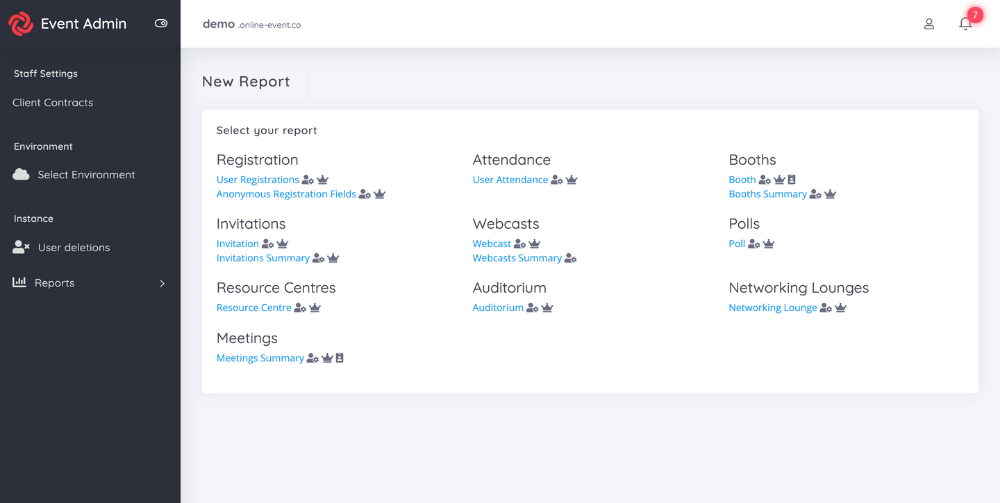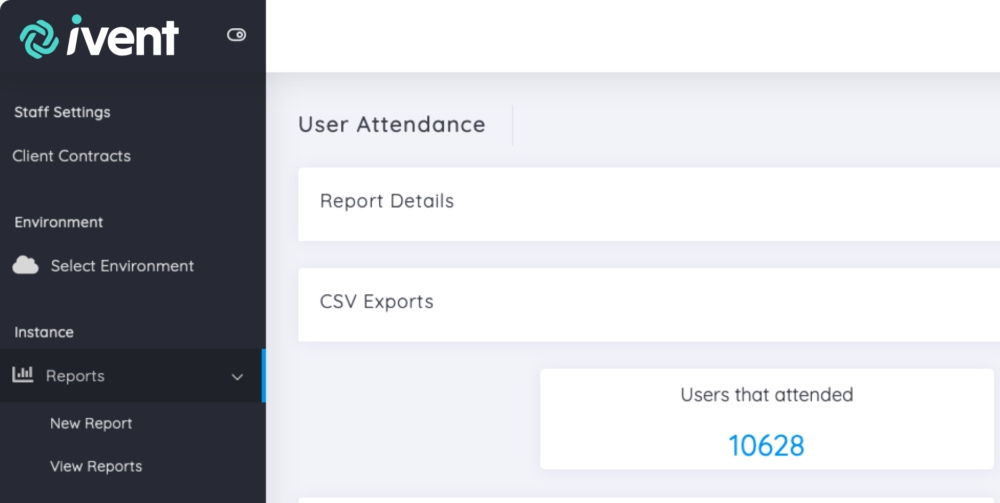How to Use Event Analytics to Measure the Success of Virtual Events

Event analytics help you work out if your event was successful.
Regardless of whether you’re trying to generate new business, reach international audiences, or create new revenue streams, you need to know what worked and what didn’t.
This is not only important in terms of providing ROI to your sponsors and exhibitors, but it helps you craft even better virtual events in the future. Otherwise you’re acting blind, and already that’s a recipe for disaster!
Ensuring your audience is engaged is vital, as there’s no point spending time and energy creating content and hosting an event if it falls flat. More importantly, you need to know that your event engaged the right audience, as this will generate quality leads for your business.
Thankfully, measuring the success of your virtual event is at your fingertips and they provide so much more detail than an in-person event. Whether you want to delve deep into click through rates, viewing times, or chat transcripts, this information is available to view at your own convenience.
Want to know about using event analytics to measure the success of your next virtual event?
I thought so!
Let’s dive in.
What are Event Analytics?
Event analytics is essentially how you track the performance of your virtual event. We’re starting with the basics here but it’s important to know what this data is before moving on to how you can use it.
In terms of management and planning, event analytics is a highly valuable tool that lets you understand your audience better.
For example:
Was there a session with a particular high attendance?
Or
Did a presentation have a short viewing time?
This data can provide so many useful insights. It tells you what kind of topics people were most interested in, what speakers were most engaging, and what event formats work best. Perhaps the session with the highest viewing figures used gamification to sustain the attention of their audience. As a result, people stayed in the session for longer as they found it engaging and fun.
Maybe the presentation on the other hand, heavily featured one speaker reeling off different pieces of information with minimal audience interaction. As a result, attendees might have got bored and left the presentation early.
In order to plan successful virtual events, knowing this information is crucial. It’s pointless creating the same type of event in the future if it doesn’t grab your audience. You need to know what they’re interested in and what they enjoy so you can tailor your content accordingly.
Fortunately, all of this information is available in the iVent analytics dashboard!
Key Event Analytics Metrics
Stay in the know when it comes to your next virtual event by understanding how to measure its success. From click through rates, to audience retention, the team at iVent have got you covered.
Let’s take a look at the different event metrics you should be measuring.
Registration Page Conversion Rate
Your registration page is highly important as this should encourage attendees to sign up. If they’re not hooked at this stage, you won’t have any attendees at all.
To find out how successful your registration page is, compare the number of event page visits to the number of people who actually went ahead and signed up. This lets you identify whether or not your landing page is working, or if it needs to be redesigned to better capture your audience.
Figuring out what your registration page conversion rate is provides an early indication of how successful your virtual event will be.
Audience Retention Rate
Keeping your audience engaged throughout your virtual event can be a challenge. Maybe they’re joining the event from home and there’s other people in the house, or maybe they’re logging on from their office and are being disturbed with questions from their colleagues. We’ve all been there!
These factors are outside of your control as you’re not physically in the same room. However, by understanding audience retention rates, you can start delivering content that keeps them tuned in for longer. Gamification, quizzes, polls, and small discussion groups are all ways you can do this, as they require input from your audience and make them feel part of the discussion.
All of these features are available on the iVent platform as we understand that engagement plays a major role in the success of your virtual event. After all, who is excited by the idea of watching a powerpoint presentation and listening to the same voice for an hour? Create a two-way conversation and give your audience a reason to stay online.
With our reporting tools, you can see viewing times for different sessions to help you work out what your audience enjoyed most. If they’re not staying around for the whole session, the chances are, it doesn’t interest them enough. Your audience should be fully invested in your presentation otherwise they’re not getting the maximum value out of it. With iVent, all of this information is yours, and can be accessed at any time.
Furthermore by using our platform, you also have the option to create ‘instant’ and scheduled meetings. Instant meetings are effective as there is no set up required which sparks immediate interest and connectivity. Scheduled meetings on the other hand, are a great way to encourage people to attend, as people are more likely to log if they have prearranged a meeting.
Attendee Conversion Rate
Of course, having lots of people register for your event sounds great. But in real terms, this is like having 50 people ‘say’ they are coming to your birthday party, but really only 20 turn up.
All of these event registrations are pointless if no one actually logs on. Therefore, you should compare the number of people who registered compared to the number of people who attended.
This matters a lot more than achieving lots of initial registrations as it shows people have been interested enough to set aside their own time.
With the iVent platform you can see a lot more than just who attended vs who didn’t. As an event admin, you can use our live map to pinpoint where attendees have come from, allowing you to tap into new opportunities and expand into different markets.
Content Views and Downloads
Another great way of measuring the success of your virtual event is knowing how many people are viewing and downloading your content.
These resources are very useful and act as a great educational tool. Whether you’re hosting an online training and learning event, or a university open day, give your attendees all of the information they need at the click of a button.
With the iVent platform you can host as many resources as you want giving you total flexibility. Unlike an in-person event which requires your attendees to carry lots of heavy catalogues and brochures, these links sit seamlessly within the platform and will still be accessible during the on-demand period.
The options are endless with this functionality as you can link attendees to specific product brochures or presentations – the choice is yours. And even better, your attendees can easily download these resources and add them to their ‘Event bag’ to view later. This gives your attendees more control over their time as they can revisit information at their own convenience.
Again, this trumps physical events as an ‘Event Bag’ is never too full.
With iVent’s Data and Analytics feature, you can see how many visitors have downloaded your resources, as well as the user details they submitted during registration. This lets you identify which leads you would like to follow up with and gives you a window into what content they’re interested in before the conversation has even started.
Number of Questions and Their Subject
As we’ve touched on, a good virtual event should be interactive and should involve more than a speaker talking to attendees. This is one of the biggest differences between a webinar and a virtual event.
Hosting a Q&A session is just one way of getting the attention of your audience and opening up a wider discussion. Perhaps your audience is still unsure about something and needs more clarity, or perhaps they want to share their own insights.
In terms of measuring event success, the more questions a session receives, the more interest it has created. If the audience is actively asking questions, then this shows they are engaged and interested in what the speaker has to say.
When planning future events, you can build more content around the sessions which received the most engagement. If the audience asked a lot of the same questions, perhaps relating to the technicalities of a specific product, then you know to expand on this moving forward.
The purpose of event analytics is to use the information you have gathered to craft successful events, based on the needs of your audience.
Post Event Survey Responses
What better way to find out how your virtual event went than asking attendees?
A post event survey is a great way to get feedback from your audience, such as what sessions they enjoyed the most and where improvements can be made. This also shows your audience that you value their opinion as you are giving them a voice.
However, no matter how successful your virtual event may be, getting feedback from your audience can be tricky. Make sure your post-event survey is succinct and clear – don’t create a lengthy questionnaire! Simply ask them questions which will provide you with useful information when planning events in the future.
Examples of questions might include:
- How likely are you to recommend the event to a friend or colleague?
- How satisfied were you with the available networking opportunities?
- How easily was it to access the event?
- What were your favourite features in the virtual event platform?
- What topics would you like to see covered in future events?
The answers to these questions will give you an insight into what worked at the event, and more importantly, what you can incorporate into your planning moving forward.
You could also use polls to measure the success of your virtual event as these are a great interactive tool. For example, use a poll within a presentation and let your audience vote on which topic they would like to learn more about. This also turns passive learners into active participants as you’re bringing them into the conversation.
Polls are a great way to evaluate what content worked best after the event is finished. Ask your audience which topics they found most interesting or which speakers were most engaging. This will help you maximise the attendee experience in future.
Social Media Engagement
Social media metrics are key when measuring the success of your virtual event. You need to know how many people are talking about it and sharing their experiences with others. This could take the form of likes, shares, and comments on your posts which helps you to grow your online network.
You’ll also want to track the number of hashtag mentions if you’ve created a specific hashtag for the event. Using a hashtag is important as it allows attendees to stay in the loop so they don’t miss any important announcements or updates. Furthermore, it makes it easy to find all event-related information in a single place instead of scrolling through various social media channels.
After hosting the event, you should check to see if your social media following has increased. This would suggest that you’ve increased your brand awareness – an indication that your event has made a positive impact on your target audience.
With the iVent platform, driving people to your social media has never been easier. Simply integrate your social media links and direct visitors towards your most popular social channels. This allows attendees to get to know you better and get a feel for your brand. Also by having attendees as connections, you have the opportunity to reach out on a 1-to-1 level, and engage with them long after the event is over. Are you ready to get started?
Get started on your events.
How to Use Event Analytics to Measure the Success of Virtual Events
Event analytics are your go-to manual when it comes to planning your next virtual event.
After all, why host a virtual event if it’s not going to be a success?
Despite the benefits of virtual events compared to in-person events such as saving you time and travel costs, these types of events still require a lot of effort and energy. Therefore, it makes sense to plan events that are tailored towards the needs of your audience.
Event analytics are the way to ensure this happens as you can identify what works and what doesn’t. You can then learn from these lessons moving forward and grab your audience with content that is relevant and enjoyable.
At iVent, this information is available to you 365 days a year.
Our reporting tools provide you with easy-to-access, transparent data that helps you measure the success of your virtual event at a time that suits you best. Your exhibitors and sponsors also get dedicated access to their data and performance, which allows them to track their ROI. However, as an event admin, your data is safe and hidden from anyone who is not supposed to see it. This gives you full control over your virtual event as you’re in the driving seat. To find out more, give our team of experts a call!




 Nikita Ovcinnikovs
Nikita Ovcinnikovs

